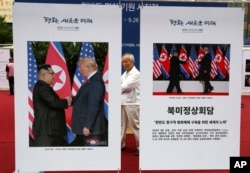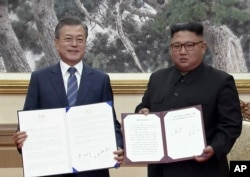North Korean leader Kim Jong Un announced Wednesday he has agreed to allow international inspectors to observe the dismantlement of facilities key to Pyongyang’s missile program. South Korean President Moon Jae-in said during the joint press conference that the era of a war-free Korean Peninsula has begun and invited Kim to Seoul, hopefully by the end of the year.
The second round of inter-Korean talks wrapped up Wednesday with the signing of the September Pyongyang Declaration and a comprehensive military agreement. The latter document, signed by South Korean Minister of National Defense Song Hyung-moo, and No Kwang Chul of People's Armed Forces of North Korea, outlined steps to ease military tensions.
The joint announcement made Wednesday concludes scheduled talks between the two leaders, although there will be additional cultural exchanges into the evening and Thursday.
Inter-Korean deal lauded as new era of peace
The September Pyongyang declaration covered a number of topics. These included the easing of military tensions, economic development, resolving family separation issues, furthering cultural exchanges, and denuclearizing the Korean Peninsula. Moon announced at the end of his remarks that Kim had accepted his invitation to visit Seoul, hopefully by the end of the year.
Kim Jong-un agreed during the talks to permanently dismantle the missile test facilities at Dongchang-ri under the observation of international inspectors. He also expressed an intent to dismantle the Yongbyon nuclear test site, although that would be contingent on the United States taking “corresponding actions.”
Harry Kazianis, Director of Defense Studies at The Center for the National Interest, tweeted one possible action would be a peace declaration, formally ending the Korean War.
“The Trump Administration will now be faced with a dilemma of enforcing principles and risking strained relations with Seoul or getting on the euphoric peace train,” wrote Heritage Foundation Senior Research Fellow Bruce Klinger in an email to VOA.
He added, “Washington was looking for Moon to deliver on real, tangible, and unambiguous North Korean commitment to abandoning its nuclear and missile arsenal. The Pyongyang Declaration was not it. The regime continues to put the onus on the United States to take appropriate, though unspecified, measures first.”
Cessation of hostilities
South Korean officials say the comprehensive military agreement signed Wednesday will create a permanent peace zone on the peninsula. As part of the agreement, the two militaries agreed to halt military exercises in the demilitarized zone beginning this November and will implement a joint military committee to facilitate regular communication and prevent accidental armed clashes.
National Security Advisor Chung Eui-yong said South Korea interpreted the pact as a non-aggression agreement and the first stage for arms control on the peninsula. He expected the agreements signed Wednesday would facilitate dialogue between Washington and Pyongyang.
That echoed comments made by South Korean President Moon, who said he hoped a second Trump-Kim summit would take place as soon as possible.
Resolving separated families and facilitating cultural exchanges
It was announced both governments would cooperate to resolve lingering issues related to separated families from the Korean War. North Korea will open a meeting facility on Mt. Kumgang to help connect loved ones and working with the Red Cross, the two governments will promote video calls and letter exchanges.
The two Koreas said they would further work to enhance cultural and art exchanges. Part of those efforts includes Seoul hosting the Pyongyang Art Company next month and both nations participating in international sporting competitions in 2020. President Moon said South and North Korea would also launch a joint bid to host the 2032 Summer Olympics.
In order to prevent the influx and spread of disease, Seoul and Pyongyang will enhance the cooperation in the prevention of epidemics, hygiene, and medical care.
To facilitate economic growth, North and South Korea said they will hold a groundbreaking ceremony, which will lead to the coastal railways and roads eventually connecting, reopening the Kaesong Industrial Complex, and resume Mt. Kumgang Mountain tourism operations. Seoul and Pyongyang are also to develop a western Special Economic Zone and an eastern Special Tourism Zone.
However, “President Moon makes economic promises he can't deliver without UN and U.S. acquiesce to accepting blatant violations of UN resolution sanctions and U.S. laws,” wrote Klinger.
A night out and a morning trip
Wednesday evening, President Moon and his delegation are to visit the Pyeongyang Daedonggang Seafood Restaurant. Presidential spokesman Yoon Young-chan told reporters it was a restaurant frequented by locals, who would join the South Korean delegation.
Following dinner, the entire South Korean delegation will head to May Day Stadium, the largest such facility in North Korea. It’s expected the 150,000 person capacity stadium will be filled for a one-hour performance entitled “Brilliant Fatherland.”
A presidential spokesman announced South Korean President Moon Jae-in and North Korean leader Kim Jong Un will visit the North’s Mount Paektu Thursday morning. It’s an active volcano on the North Korea - Chinese border and considered the spiritual home of Koreans.
President Moon and his delegation are expected to return to Seoul later Thursday morning.
Lee Ju-hyun contributed to this report.











